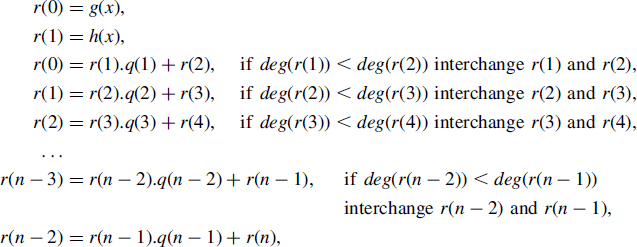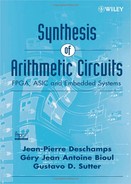2.2 ALGEBRA
2.2.1 Groups
Definition 2.10 A group (G, *, 1) consists of a set G with a binary operation * and an identity element 1 satisfying the following three axioms:


- for each element x of G there exists an element x−1, called the inverse of x, such that

If, furthermore,
 (commutativity), the group is said to be commutative (or Abelian).
(commutativity), the group is said to be commutative (or Abelian).
Axioms 1 and 2 define a semigroup.
Examples 2.6
(Z, +, 0), (Zn, +, 0), (![]() , ., 1)
, ., 1)
The following definitions generalize Definitions 2.9.
Definitions 2.11
- The order of an element x of a finite group G is the least positive integer t such that

- If the order of x is equal to the number n of elements in G, then x is said to be a generator of G.
- If G has a generator, then G is said to be cyclic.
Property 2.6 The order of an element x of a finite group G divides the number of elements in G..
Proof First observe that if H is a subgroup of G, then an equivalence relation on G can be defined: g1 ≡ g2 if there exists an element h in H such that g1.h = g2. The number of elements in an equivalence class is equal to the number |H| of elements in H. Thus the number |G| of elements in G is equal to |H|.|G/H|, with G/H the set of classes and |G/H| the number of classes. In other words the number of elements of a subgroup divides the number of elements of the group. It remains to observe that the set {x, x2, …, xt = 1}, where t is the order of x, is a subgroup, so that the number t of elements of the subgroup divides the number of elements in G.
Example 2.7
(![]() , ., 1);
, ., 1);
3 and 5 are generators;
the subgroup generated by 2 is {2, 4, 1}; the corresponding classes are then {2, 4, 1} and {6, 5, 3}; the number of elements (3) of the subgroup divides the number of elements (6) of ![]() .
.
2.2.2 Rings
Definition 2.12 A ring (R, +, *, 0, 1) consists of a set R with two binary operations + and *, an additive identity element 0, and a multiplicative identity element 1 satisfying the following axioms:

Examples 2.8
(Z, +, ., 0, 1), (Zn, +, ., 0, 1)
2.2.3 Fields
Definition 2.13 A field (F, +, *, 0, 1) consists of a set F with two binary operations + and *, an additive identity element 0, and a multiplicative identity element 1 satisfying the following axioms:
- (F, +, *, 0, 1) is a commutative ring;
- all nonzero elements of F have a multiplicative inverse.
Example 2.9
(Zp, +, ., 0, 1), where p is a prime.
2.2.4 Polynomial Rings
Definitions 2.14
- If F is a field, then a polynomial in the indeterminate x over F is an expression of the form

where

- The largest integer m (if any) such that am ≠ 0 is the degree of f(x). It is denoted deg(f) and am is called the leading coefficient. If all the coefficients of f(x) are equal to 0, then f(x) is called the zero polynomial and its degree defined to be equal to − ∞. The 0-degree polynomials are also called constant polynomials.
- A monic polynomial is a polynomial whose leading coefficient is equal to 1.
- The polynomial ring F[x] is the ring formed by the set of all polynomials in the indeterminate x with coefficients in F. The two operations are the standard polynomial addition and multiplication, with coefficient arithmetic performed in F. The additive identity element 0 is the zero polynomial. The multiplicative identity element 1 is the monic constant polynomial.
Definition 2.15 Thanks to the fact that F is a field, so that all the nonzero coefficients have an inverse, the standard polynomial division can also be performed. Thus, if g(x) and h(x) ≠ 0 are polynomials in F[x], then there exist two polynomials q(x) (the quotient) and r(x) (the remainder) in F[x] such that
Notation:
![]()
Definitions 2.16
- Given two polynomials g(x) and h(x), h(x) divides g(x) (or h(x) is a divisor of g(x)) if there exists a polynomial q(x) such that g(x) = q(x).h(x).
- Given two polynomials g(x) and h(x), not both equal to 0, the greatest common divisor of g(x) and h(x) is the monic polynomial of greatest degree which divides both g(x) and h(x).
- gcd(0, 0) = 0.
- A polynomial f(x) of degree at least 1 is said to be irreducible if it cannot be written as the product of two polynomials, each of positive degree.
A variant of the Euclidean algorithm for polynomials (VZG2003) expresses the greatest common divider of two polynomials g(x) and h(x) in the form
![]()
The algorithm is based on the fact that if u(x) and v(x) are two polynomials such that
![]()
that is,
![]()
![]()
where deg(r!) < m, so that
where
![]()
so that
![]()
Furthermore,
![]()
The sequence of operations is almost the same as for computing the greatest common divider of two integers. A series of polynomials r(0), r(1), r(2), … are generated. Initially, assume that deg(g) > deg(h) and define
![]()
At each step the decomposition (2.8) is used:
![]()
so that
![]()
where
![]()
At the end of the step, r(i) and r(i + 1) are interchanged if deg(r(i)) < deg(r(i + 1)).

where
![]()
and
![]()
so that
![]()
Let r0 be the coefficient of x0 in r(n). If r0 = 0, then
![]()
If r0 ≠ 0, then
![]()
In parallel with the computation of r(0), r(1), r(2), … , r(n), two series of polynomials b(i) and c(i) are generated:

It can be demonstrated by induction that
![]()
So, if r0 = 0, then
![]()
and if r0 ≠ 0, then
![]()
In the following algorithm u stands for r(i − 1), v for r(i), r for r(i + 1), b for b(i − 1), d for b(i), bb for b(i + 1), c for c(i − 1), e for c(i), and cc for c(i + 1):
Algorithm 2.3 Variant of the Extended Euclidean Algorithm for Polynomials
2.2.5 Congruences of Polynomial
Definition 2.17 Given three polynomials g(x), h(x), and f(x) in F[x], g(x) is congruent to h(x) modulo f(x) if f(x) divides g(x) − h(x).
Notation:
![]()
Properties 2.7 (Properties of Congruences)
- g(x) ≡ h(x) (mod f(x)) if and only if (g(x) mod f(x)) = (h(x) mod f(x)) (Definition 2.15);
- the relation g(x) ≡ h(x) (mod f(x)) is an equivalence relation (reflexive, symmetric, and transitive);
- if g1(x) ≡ h1(x) (mod f(x)) and g2(x) ≡ h2(x) (mod f(x)), then
From Properties 2.7(1 and 2) it can be seen that the congruence relation partitions F[x] into equivalence classes. If n is the degree of f(x), then each equivalence class contains exactly one polynomial of degree d < n. So, if F is a finite field, then the number of equivalence classes is equal to |F|n, where |F| is the number of elements in F. Furthermore, according to Property 2.7(3), the addition, subtraction, and multiplication of congruence classes can be defined. As a matter of fact, the set of equivalence classes is isomorphic to
![]()
where the addition, the subtraction, and the multiplication are defined by
![]()
The set of equivalence classes is denoted F[x]/f(x).
Properties 2.8
- F[x]/f(x) is a commutative ring.
- If f(x) is irreducible, then F[x]/f(x) is a field.
Proof
- Consequence of Property 2.7(3).
- If f(x) is irreducible, then the greatest common divisor of f(x) and g(x) ≠ 0 is 1. Using the Euclidean algorithm (Algorithm 2.2), b(x) and c(x) can be computed such that

and

Definition 2.18 Let p be a prime, F = Zp, and f(x) be an irreducible polynomial of degree n over Zp. The corresponding field F[x]/f(x) contains q = pn elements and is called either Fq or GF(q) (Galois field).
As a matter of fact, it can be demonstrated that any finite field contains q = pn elements, for some prime p and some positive integer n, and is isomorphic to Fq (whatever the irreducible polynomial f(x) of degree n over Zp). In particular, if n = 1, then the corresponding field Fp is isomorphic to Zp.
The set of 0-degree polynomials (the constants) is a subfield of Fq isomorphic to Fp. If g(x) is a 0-degree polynomial (an element of Fp) then, according to the Fermat's little theorem, (g(x))p = g(x). Conversely, it can be demonstrated that if a polynomial g(x) satisfies the condition (g(x))p = g(x), then g(x) is a constant.
Another interesting property of Fq is that the set ![]() of nonzero polynomials is a cyclic group. Let g(x) be a nonzero polynomial, that is, an element of
of nonzero polynomials is a cyclic group. Let g(x) be a nonzero polynomial, that is, an element of ![]() , and assume that the order of g(x) is t. According to the Property 2.6, t divides q − 1, so that (g(x))q−1 = (g(x))t.k = 1k = 1. Consider now a polynomial g(x) and define h(x) = (g(x))r, where r = (q − 1)/(p − 1). According to the previous property, (h(x))p−1 = (g(x))q−1 = 1 and (h(x))p = h(x), so that h(x) is a constant polynomial.
, and assume that the order of g(x) is t. According to the Property 2.6, t divides q − 1, so that (g(x))q−1 = (g(x))t.k = 1k = 1. Consider now a polynomial g(x) and define h(x) = (g(x))r, where r = (q − 1)/(p − 1). According to the previous property, (h(x))p−1 = (g(x))q−1 = 1 and (h(x))p = h(x), so that h(x) is a constant polynomial.
A last property, useful for performing arithmetic operations, is that (g(x) + h(x))p = (g(x))p + (h(x))p. It is a straightforward consequence of the fact that all the binomial coefficients (p!/(i!).(p − i)!) are multiples of p, except for i = 0 or p.
To summarize:
Properties 2.9 (Some Useful Properties of Finite Fields)
- The set of 0-degree polynomials in Fq is a subfield of Fq isomorphic to Fp.
- Given g(x) in Fp, then (g(x))p = g(x) (Fermat's little theorem).
- Given g(x) in Fq such that (g(x))p = g(x); then g(x) ∈ Fp.
- The set of nonzero polynomials of Fq is a cyclic group denoted
 .
. - Given g(x) in Fq, then (g(x))q = g(x).
- Given g(x) and h(x) in Fq, then (g(x) + h(x))p = (g(x))p + (h(x))p.
- If r = (pn − 1)/(p − 1), that is, r = 1 + p + p2 + … + pn−1, and g(x) is an element of Fq, then (g(x))r is an element of Fp.
Example 2.10 p = 2, n = 4, f(x) = 1 + x + x4 so that x4 ≡ 1 + x mod f(x); α = x is a generator of the cyclic group ![]() :
:

Given a polynomial ![]() then
then
![]()
if (g(x))2 = g(x), then
![]()
thus
![]()

